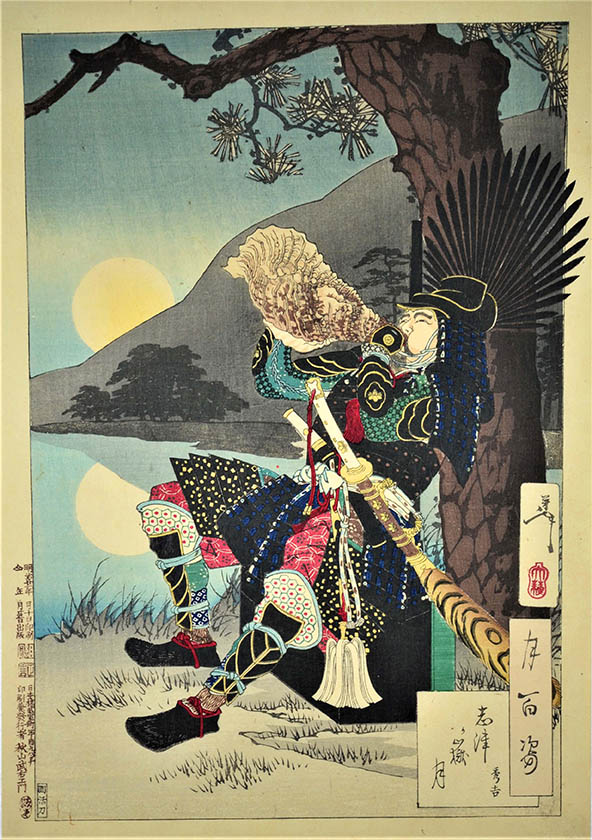Tsukioka Yoshitoshi (1839-1892) is recognized as one of the great masters of the Ukiyo-e tradition. His celebrated series, One Hundred Aspects of the Moon, completed shortly before his death, epitomizes the restraint and subtlety that mark his mature work. The series of one hundred woodblock prints depicts figures from Japanese and Chinese mythology, folklore, history, literature, and theater. Each subject is captured at a moment in time and held suspended by a poetic dialogue with the moon. The series was so popular that townspeople were said to have lined up before dawn to buy a print of the latest image.
Holding back the night, With its increasing brilliance, The summer moon
– Yoshitoshi’s death poem
Bon Festival Moon (Bon no tsuki)
Bon Festival Moon (Bon no tsuki)
Woodblock print; ink and colors on paper
Meiji period, February 1887
Museum purchase
2020.008.002
O-bon is a joyous summer festival held annually on a full moon of the seventh lunar month to honor the spirits of family ancestors. A highlight of the celebration is a group dance, or bon odori, in which young and old don light, informal cotton kimonos, called yukata, and dance up and down the streets and sing late into the night.
Grave Marker Moon (Sotoba no tsuki)
Grave Marker Moon (Sotōba no tsuki)
Woodblock print; ink and colors on paper
Meiji period, March 1886
Gift of Beverly Crown
2006.034.010
The 9th century poet Ono no Komachi was once renowned for her beauty, position, and wealth. Her brilliance earned her a place as the only woman in the group Rokkasen, or “Six Poets.” However, her arrogance eventually led to her downfall. Wandering destitute as an old woman, Komachi rests upon a fallen grave marker under a waning moon and reflects on the misguided passions of her life.
Shizu Peak Moon (Shizugatake no tsuki)
Shizu Peak Moon (Shizugatake no tsuki)
Woodblock print; ink and colors on paper
Meiji period, October 1888
Gift of Beverly Crown
2006.034.014
The great military commander Toyotomi Hideyoshi (1536-1598) led his troops on a fifty-mile march to Shizu Peak outside Kyoto. Taking out his famous conch shell, Hideyoshi trumpets the signal to attack as the dawn moon sets behind the hill. The Battle of Shizugatake was a crucial victory for Hideyoshi’s army.
The Cry of the Fox (Konkai)
The Cry of the Fox (Konkai)
Woodblock print; ink and colors on paper
Meiji period, Janurary 1886
Gift of Beverly Crown
2006.034.007
In Japan, folk beliefs are rich with tales of foxes that have the magical power to disguise themselves as humans. In this illustration based on a kyōgen, a popular form of comic theatrical interlude, a fox has disguised itself as an old priest in order to persuade the priest’s nephew, a hunter, to stop trapping foxes. In this print, we see the fox in the midst of changing back into its original form.
Moon of the Lonely House (Hitotsuya no tsuki)
Moon of the Lonely House (Hitotsuya no tsuki)
Woodblock print; ink and colors on paper
Meiji period, August 1890
Gift of Beverly Crown
2006.034.016
The old woman creeping around the corner is the subject of a popular story and several dramas, all of which preyed on the fears of many Japanese. According to one version, the woman was the demented mistress of an old house on an isolated moor. She served a lord who had a strange disease for which the only cure was human blood. The woman obtained his medicine by killing travelers who stayed at her house, typically with a huge kitchen knife.
The Moon of the Moor (Harano no tsuki)
The Moon of the Moor (Harano no tsuki)
Woodblock print; ink and colors on paper
Meiji period, May 1888
Gift of Beverly Crown
2006.034.013
In a famous legend retold in both theater and dance, the courtier Fujiwara no Yasumasa (958-1036) was strolling home through the moors one evening playing his flute. A bandit named Hakamadare Yasusake crept up from behind intent on killing him for his fine robes. In moments, however, Hakamadare was mesmerized by the beautiful music and was unable to carry out the attack.
Full moon on the tatami mats, shadows of the pine branches – Kikaku
Full moon on the tatami mats, shadows of the pine branches – Kikaku
Woodblock print; ink and colors on paper
Meiji period, October 1885
Gift of Beverly Crown
2006.034.004
A courtesan leans out the veranda of a luxurious teahouse and gazes at the shadows cast by the moon. The red maple leaves on the painted screen and the aboveground brazier, used in tea ceremony, indicate that the scene takes place in early autumn. This print illustrates the above haiku by the renowned poet Takarai Kikaku (1661-1707), who was known to spend a great deal of time in the pleasure quarters.






